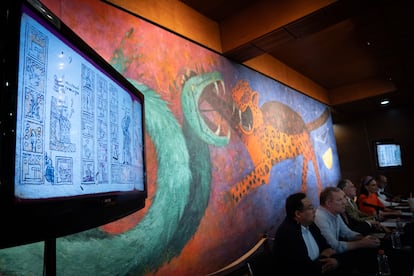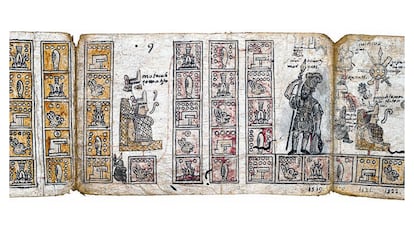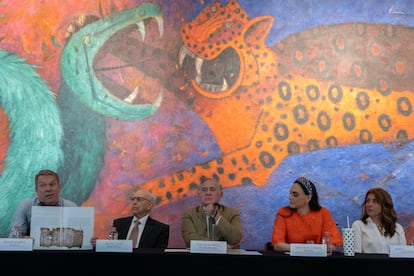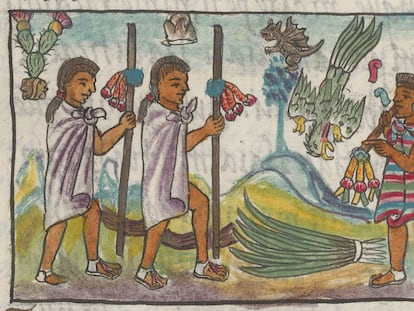Mexican government acquires long-lost Aztec manuscripts about the rise and fall of Tenochtitlan
Experts will analyze the Codices of San Andrés Tetepilco to unravel the history of Mexico’s old imperial capital


María Castañeda de la Paz still vividly recalls discovering the Codices of San Andrés Tetepilco in 2009. While on vacation, a colleague mentioned a friend who had some potentially interesting manuscripts. She went to a meeting in Mexico City’s ritzy Coyoacán neighborhood and was amazed to find copies of these codices, one of which narrates the history of Tenochtitlan, the Aztec empire’s ancient capital. “It’s not every day you come across documents like this,” said Castañeda de la Paz. “I was thrilled and surprised because documents about the history of Tenochtitlan are very rare.” She is among a team of experts who unveiled the discovery on March 20 at the National Museum of Anthropology in Mexico City. After years of research and negotiations, the Mexican government paid 9.5 million pesos (roughly $500,000) to the family that owned these historical manuscripts.



The effort to acquire documents dating from the late 16th century and early 17th century was long and fraught with setbacks. “The person who showed me photos of the codices on a computer mentioned they belonged to a family, but didn’t provide details other than the family had two or three documents. I was given some color copies to analyze, and I suggested registering them to prevent a rise in black market value. The family wasn’t interested in that, and I started to have some doubts about who really owned the codices. I tried many times to contact the family but they were unresponsive, and unfortunately their interest eventually faded,” said Castañeda de la Paz, a researcher at the Anthropological Research Institute of Mexico’s National Autonomous University (UNAM).

Unable to persuade the family with the valuable manuscripts, Castañeda de la Paz contacted Baltazar Brito Guadarrama, head of the National Library of Anthropology and History (BNAH), and showed him the copies. Brito then led the effort to contact the family and acquire the codices. “I was totally surprised when I opened the little box they were in. And when I lifted the first sheet, I just knew it was an original document,” said Brito. The National Institute of Anthropology and History (INAH) hasn’t disclosed the owners’ identities, but Brito says they said the documents were passed down through generations in the same family.
Brito explained that under Mexican law, historical assets like a painting from the viceroyalty period can be privately owned or inherited but must stay in Mexico. INAH experts have now verified the authenticity of the three codices about Mexico City’s history. The first one tells the story of San Andrés Tetepilco’s founding in Iztapalapa, south of Mexico City. The second lists the assets of San Andrés Tetepilco church on two sheets of amate (bark) paper. The third codex is what Castañeda de la Paz calls “the jewel in the crown.” INAH considers it the most significant codex because of its “formal narration of Tenochtitlan’s history through four main themes: the city’s founding in the 14th century; records of pre-Hispanic tlatoque lords; the Spanish conquistadors’ arrival in 1519; and the viceroyalty period until 1611.”

Historian Rafael Tena stated that after the Spanish arrived, the Indigenous people of Mexico continued creating codices and were influenced by European culture, incorporating techniques like the third dimension, shading and perspective. They also added comments in both the original languages and Spanish. By the end of the 16th century, Tena says the codices were no longer produced and many ended up in private hands in Europe and the United States. “We have half of all codices ever created, and it’s remarkable that centuries later, we are still discovering new materials that enrich our national heritage and historical knowledge.”
The newly presented codices will undergo additional research and conservation processes before being stored in BNAH’s priceless codex collection. “The timeline of what we know about our history is being revised, and that’s pretty surprising,” said Castañeda de la Paz. She is still amazed by the existence of these invaluable manuscripts, now accessible to experts seeking deeper insights into the intricate puzzle of Mexican history.
Sign up for our weekly newsletter to get more English-language news coverage from EL PAÍS USA Edition
Tu suscripción se está usando en otro dispositivo
¿Quieres añadir otro usuario a tu suscripción?
Si continúas leyendo en este dispositivo, no se podrá leer en el otro.
FlechaTu suscripción se está usando en otro dispositivo y solo puedes acceder a EL PAÍS desde un dispositivo a la vez.
Si quieres compartir tu cuenta, cambia tu suscripción a la modalidad Premium, así podrás añadir otro usuario. Cada uno accederá con su propia cuenta de email, lo que os permitirá personalizar vuestra experiencia en EL PAÍS.
¿Tienes una suscripción de empresa? Accede aquí para contratar más cuentas.
En el caso de no saber quién está usando tu cuenta, te recomendamos cambiar tu contraseña aquí.
Si decides continuar compartiendo tu cuenta, este mensaje se mostrará en tu dispositivo y en el de la otra persona que está usando tu cuenta de forma indefinida, afectando a tu experiencia de lectura. Puedes consultar aquí los términos y condiciones de la suscripción digital.
More information
Archived In
Últimas noticias
Most viewed
- David King, chemist: ‘There are scientists studying how to cool the planet; nobody should stop these experiments from happening’
- Reinhard Genzel, Nobel laureate in physics: ‘One-minute videos will never give you the truth’
- Mexico completes its trade shift with the entry into force of tariffs on China and countries without trade agreements
- Oona Chaplin: ‘I told James Cameron that I was living in a treehouse and starting a permaculture project with a friend’
- Sinaloa Cartel war is taking its toll on Los Chapitos










































